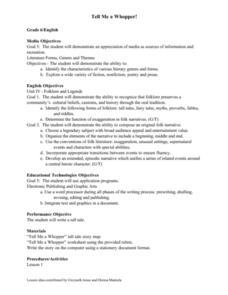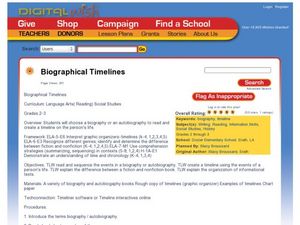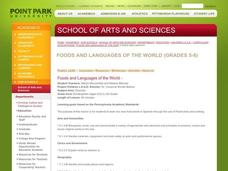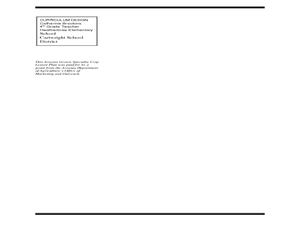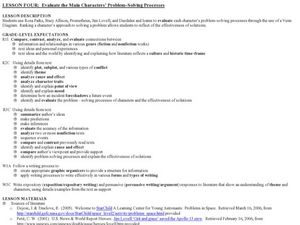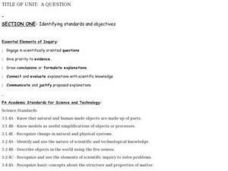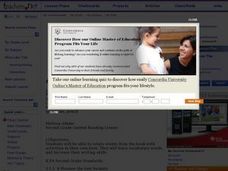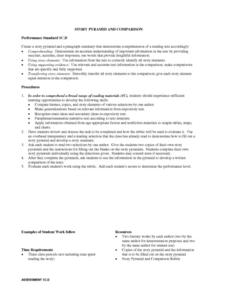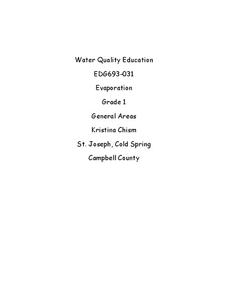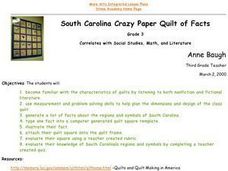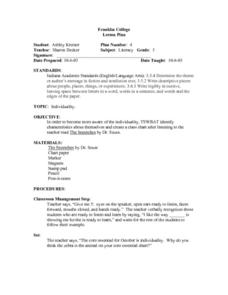Curated OER
Tell Me a Whopper!
Sixth graders investigate tall tales as a literary genre. They listen to a number of tall tales to discover how exaggeration is used as a story element. They write and publish a tall tale using word processing software. They illustrate...
Curated OER
Autobiographical Postage Stamp
Pupils design a postage stamp that communicates to the world who they are, what they hope to be, what they are good at, and factual information. They use, "My Great Aunt Arizona" by Gloria Houston as a model for a biography.
Curated OER
Biographical Time lines
Students create a time line. In this biography lesson, students define biography and autobiography and then read short examples of each. Students create a time line using a read aloud.
Curated OER
Juvenile Delinquency
Ninth graders analyze and interpret historical research by examining, analyzing, and forming opinions regarding primary resources. They compare/contrast social conflict, its causes and effects, in regards to continuity and change over time.
Curated OER
"The Scientist and The Prince: Two Interesting Early Pennsylvania Immigrants
Young scholars examine immigrants including why people immigrated to America and their places of origin. In this immigrants instructional activity students analyze the importance of immigrants and the obstacles that they...
Curated OER
Foods and Languages of the World
Young scholars review Mexico's location and language and learn to pronouns 10 new Spanish food words. Students listen as the book, Corn is Maize is read, touching and passing around an ear of Indian corn. Young scholars discuss the...
Curated OER
Lesson Two: Rock N Rhythm & Rhyme (Part Two)
Second graders find rhythm and rhyme in poetry. In this poetry lesson, 2nd graders listen to different poems to find the rhyming words. They play a memory game and try to find two words that rhyme.
Curated OER
Roebling and Suspension Bridges: A Thread of Steel
Students create a model bridge using steel. In this bridges lesson plan, students study John Augustus Roebling and how he created bridges out of steel and the impact it had on society. Then students build their own bridge model.
Curated OER
The Individual and His Role in Society
Tenth graders discover how various writers approach the themes of : alienation and solitude, living life "deliberately" and "phonies." Through reading, journaling, class discussion, and writing assignments they realize the power of the...
Curated OER
Analysis of Character in a Short Story
Ninth graders examine a character from the short story, John Steinbeck's, "Flight." students respond to questions about the story and illustrate the character's journey.
Curated OER
Let's Make Stew!
Students investigate how to create a vegetable garden and complete related activities. In this vegetable garden lesson, students receive agriculture notebooks to complete vocabulary for the gardening lesson. Students read 'Still-Life...
Curated OER
Evaluate the Main Characters? Problem-Solving Processes
High schoolers read passages from several sources and evaluate the text for various criteria. In this problem solving lesson, students evaluate character problem solving processes after reading passages. They will use a Venn Diagram to...
Curated OER
If These Walls Could Talk: Seeing a Culture Through Human Features
Students read Talking Walls and discuss the walls presented and their importance to the culture. In this geography lesson, students locate and label each country/continent discussed in the book on a world map. Students take a walk and...
Curated OER
Famous Poems and Poets
Students investigate well known poets, forms, and poetry terms. They explore various websites, complete an online scavenger hunt, and take an online poetry test.
Curated OER
The Human Jigsaw
Fourth graders, using Thomas Paine's "The Crisis, No. 1" from The American Crisis, form a human jigsaw.
Curated OER
From Seeds to Plants
Second graders review the process of plant reproduction and the role of seeds in that process. The students dissect a seed, analyze their finds, collect and record data, and make predictions about seed germination and plant growth.
Curated OER
The Grouchy Ladybug
Students complete a Cirlce Map about time. They recall times during the grouchy ladybugs travels, and add dots on ladybugs using turn-around facts. Pupils correctly sequence the events of The Grouchy Ladybug. Students compose new...
Curated OER
A QUESTION
Young scholars engage in scientifically oriented questions. They give priority to evidence, draw conclusions/formulate explanations and connect/evaluate explanations with scientific knowledge. Students communicate and justify proposed...
Curated OER
Flat Stanley Guided Reading
Second graders listen to their teacher read the book, "Flat Stanley". They relate the activities in the book to activities in their own life. They can also create their own pictures of Stanley.
Curated OER
Story Pyramid And Comparison
Students investigate the details of a chosen story of literature. They use a pyramid graphic organizer to record information. The information is used to write a summary of the story. Students use a rubric while writing the summary to...
Curated OER
Why is Reading Important?
Ninth graders discuss why reading is an important skill for them to use in their lives. In groups, they examine the problems someone might have out in the world if they are illiterate. They practice reading in ways that it makes it fun...
Curated OER
Evaporation
First graders explore, analyze, document and study weather and the water cycle. They observe the weather and begin a weather journal. Each student interacts with the concepts of evaporation, condensation and precipitation, clouds,...
Curated OER
South Carolina Crazy Paper Quilt of Facts
Third graders listen as the teacher reads a book about quilts, before they discuss the craftsmanship used in making quilts. They study the regions and symbols associated with their state. They make a quilt square using one of the facts...
Curated OER
Language Arts: What Makes an Individual
Third graders listen to the teacher read "The Sneetches" prior to creating charts about their individual characteristics. After numerous examples of individuality, they compile them on chart paper. As an extension, 3rd graders write...
